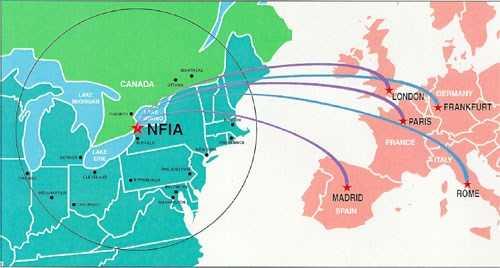Air Cargo
A Trade Center
In 2003, the Port of Buffalo Niagara was the ninth largest port in the U.S. with total trade flows of $59 billion. However, after consolidating statistics of ports that serve the same region, the Buffalo Niagara region jumps to the sixth largest trading region in the U.S. after Los Angeles (with three ports), New York City (with two ports), Detroit, Laredo, and Port Huron (each with one port).
Among land ports, the Port of Buffalo Niagara ranked fourth behind the Port of Detroit, Laredo, and Port Huron.
The $55.1 billion worth of goods passing through the Port of Buffalo Niagara accounts for three percent of all US trade with the world. Exports accounted for 45.8 percent of the Port’s 2003 trade flow while imports accounted for the remainder.
In terms of 2002 U.S. trade with its North American Free Trade Agreement (NAFTA) partners, the Port of Buffalo Niagara ranked as the third largest port with total trade flows equal to $54.9 billion. Trade with Canada accounted for 99 percent of this total.
Canada exports $21.4 billion by truck into the United States with an additional $7.13 billion by rail. Twenty-six percent of all exports are destined for JFK and EWR airports for final transport by air.
Manufacturing Base
The manufacturing sector is a key part of Buffalo Niagara regional economy. As of 2003, the Buffalo Niagara region had 2,000 firms active in the manufacturing sector (accounting for 5.4 percent of all companies in the region), which employ 94,000 people (accounting for 14.1 percent of all jobs in the region).
Several strong industry clusters have emerged from the manufacturing sector:
- Automobiles and Automotive Components: Major corporations such as General Motors, Ford, Motorola, and American Axle produce various automotive components. Many of these companies have committed substantial capital investments to their facilities.
- Medical Devices: The extended Buffalo Niagara region (reaching from Toronto to Buffalo to Syracuse) is home to more than 850 medical industry companies, including renowned medical equipment, research and health care institutions. This rapidly expanding cluster includes such established companies as MDS Proteomics, Vaccinex, Mentholatum Company, Kimberly-Clark, Invitrogen, Bausch & Lomb, Proctor & Gamble Pharmaceutical, and Welch Allyn.
Food and Food-Related Products: The Buffalo-Niagara region has a higher concentration of employment in the food processing industry than the national average, with approximately 300 firms providing approximately 12,000 jobs. This accounts for 17% of all food processing jobs in New York State. The majority of these jobs are in the food manufacturing sector. The region also has the highest concentration of food machinery manufacturers in the state, as well as high concentrations of dairy farms and food processors.
New York State Exports and Imports by Commodity (2004)
|
Exports
|
Imports
|
|||
|
|
Commodity |
Value |
Commodity |
Value |
|
#1 |
Industrial Machinery |
21.83 |
Autos and Auto Parts |
27.51 |
|
#2 |
Electric Machinery |
14.52 |
Precious Metals and Stones |
24.16 |
|
#3 |
Precious Metals and Stones |
13.93 |
Mineral Fuels and Oils |
20.24 |
|
#4 |
Autos and Auto Parts |
10.12 |
Industrial Machinery |
20.13 |
|
#5 |
Optic/Photo Equipment and |
9.72 |
Electric Machinery |
12.41 |
|
#6 |
Plastics and Plastic Articles |
5.09 |
Unknit Apparel |
10.61 |
|
#7 |
Pharmaceuticals |
4.36 |
Pharmaceuticals |
10.32 |
|
#8 |
Aircraft/Spacecraft and Parts |
4.06 |
Knit Apparel |
7.95 |
|
#9 |
Works of Arts/Collectors |
2.77 |
Organic Chemicals |
6.89 |
|
#10 |
Mineral Fuels and Oils |
2.62 |
Optic/Photo Equipment and |
|
Few areas in the United States rival the Niagara region in its capability to serve international trade and freight. The abundance of goods moving among the region’s border crossings makes Buffalo Niagara the eighth busiest U.S. international freight gateway, and fourth for international freight traveling by ground.
Responding to the needs of the cross-border trade, Buffalo Niagara’s workforce and business climate provides extensive experience in the essential support services required to accommodate international freight. With a seasoned logistics industry that includes customs brokers, freight forwarders and trucking companies, Buffalo Niagara's soft infrastructure gives the NFIA a competitive edge other inland airports envy.
Air cargo is a natural fit for the Niagara Falls International Airport. With the increase costs of fuel, landing fees, and infrastructure expenses in the major urban centers, operating out of the NFIA makes sense.
Accessibility
Buffalo Niagara is a region comprising eight counties of western New York State, on the border of the Niagara Peninsula of Ontario, Canada. The region is served by four international bridges connecting the U.S. and Canada and two train crossings. The Niagara Falls International Airport is centrally located for distribution to and from major population centers, easily reached from the U.S. highway system.
|
Highway Distance to Major Cities (miles) |
|
|
Atlanta, GA 895 |
Miami, FL 1,393 |
|
Baltimore, MD 386 |
Montreal, PQ (Can.) 413 |
|
Boston, MA 482 |
New York, NY 371 |
|
Chicago, IL 556 |
Philadelphia, PA 400 |
|
Cleveland, OH 190 |
Pittsburgh, PA 240 |
|
Kansas City, MO 991 |
Toronto, Canada 112 |
|
Memphis, TN 928 |
Washington, DC 379 |





(716) 297-4494 | TTY/Relay 711 or (800) 662-1220